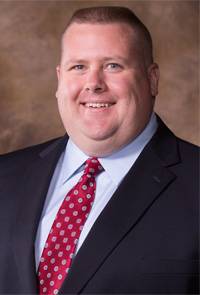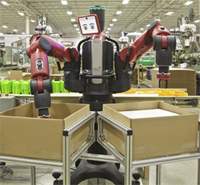Department of Industrial Engineering
4207 Bell Engineering Center
1 University of Arkansas
Fayetteville, AR 72701
Phone: (479) 575-3156
Fax: (479) 575-8431
New Industrial Engineering Professor Helps Robots and Humans Work Together
 Research somewhere between industrial and mechanical
Research somewhere between industrial and mechanical
Harry Pierson, assistant professor of industrial engineering, describes his research as being “between industrial and mechanical.” With a background in mechanical, manufacturing and systems engineering, Pierson has insight into the processes and systems involved in industrial manufacturing.
One of Pierson’s research focuses is on collaborative robots. This new generation of robots presents new opportunities for manufacturers. Traditionally, industrial robots are dangerous machines. They are separated from human workers, except for the specialized programmers and engineers who give the robots instructions. Collaborative robots are different. These robots have features that allow them to safely and easily interact with humans.
 Pierson explained that the robot he just acquired for his lab, named Baxter, has sensors
and force feedback, which means it can sense the presence of humans and react to them.
“If you get in front of him, he’ll stop,” said Pierson. Baxter also has a pair of
eyes that “look” in the direction it is moving or reaching toward, to help its human
co-workers know what to expect.
Pierson explained that the robot he just acquired for his lab, named Baxter, has sensors
and force feedback, which means it can sense the presence of humans and react to them.
“If you get in front of him, he’ll stop,” said Pierson. Baxter also has a pair of
eyes that “look” in the direction it is moving or reaching toward, to help its human
co-workers know what to expect.
Baxter the Robot
Another feature of this robot is called “human friendly task specification.” Instead of needing complicated programmed instructions, Baxter can repeat processes that he’s learned directly from people. A human worker can move the robot’s arm through a task, for example, and Baxter will record the task so that he can repeat it.
All these features mean that collaborative robots such as Baxter can work alongside anyone, even workers without the advanced skills needed to interact with traditional industrial robots. Pierson is investigating ways to use this new technology to make the manufacturing process more efficient and cost effective, especially for small businesses.
Pierson is also looking at another breakthrough in manufacturing—3D printing. This technology has the potential to benefit many different industries, especially ones that need small amounts of custom-designed parts. Pierson is working with the Air Force, looking at 3D printing processes and specifications to make sure that 3D printed parts will be reliable.
Pierson received a bachelor’s degree in mechanical engineering and a master’s degree in engineering management from the University of Missouri-Rolla. He holds a doctorate in industrial and systems engineering from The Ohio State University. Pierson has worked as a visiting assistant professor of mechanical and manufacturing engineering at Miami University, and has experience in the manufacturing industry through positions with Spang & Co. and Ingersoll-Rand. His wife, Jessica, works for the online writing center at Columbus State Community College. They have two sons.
Contacts:
Camilla Shumaker, director of communications
College of Engineering
479-575-5697,
camillas@uark.edu
Release date: Sept. 04, 2014